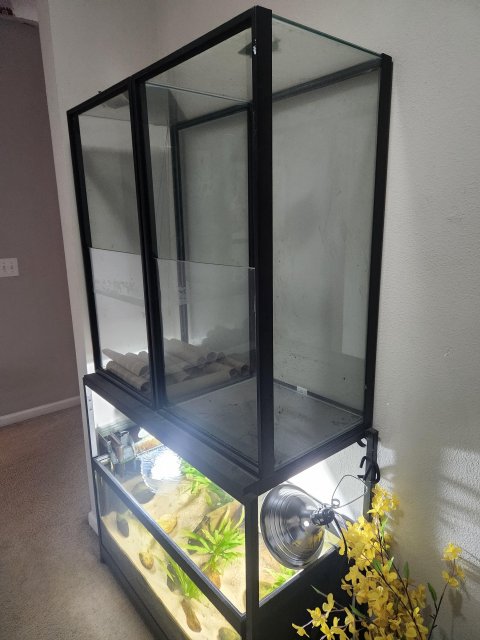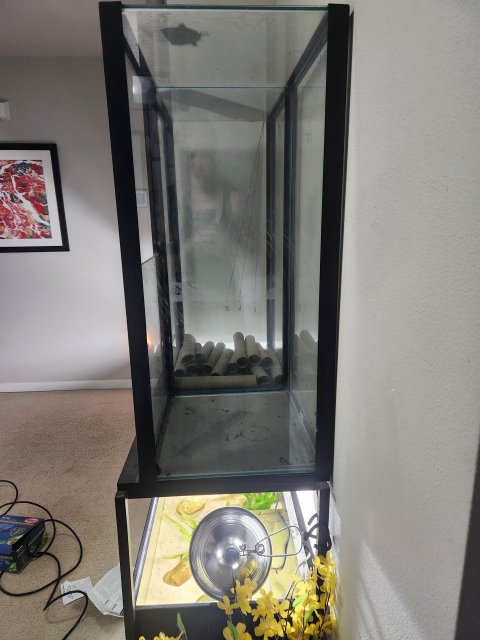I feel pompous saying paludarium. Terrarium to less technical older people (like me).
My fiancé (as a lifelong bachelor I'm still getting used to saying that) loves house plants and in the last few years we've been working them into my aquatic hobby. Which has me looking for ways to convert some "fish tanks" into terrariums / vivariums / paludariums.
In the hallway I have a typical metal stand that's meant to have two 40 breeders stacked one above the other.
So what I did was, I set up a 40 breeder on bottom, pretty normal. Lightly planted. AC110/500. It's been a cherry shrimp tank for years with a few different fish species making temporary appearances. But the top of that rack is where it's getting exciting...
Instead of a single 40 breeder on top... I have two 40 breeders standing on end turned with the opening toward the front. I had glass panels custom cut to fit perfectly covering the bottom half of the opening and siliconed them in place. They sat in my warehouse at work holding water for about 6 months to convince me they can be trusted to remain water tight in the house. I trust them. See Photos...
The plan is to build a concrete background with plumping installed to make the backwall a waterfall (what was originally the bottom). Have multiple cups (with a drain hole) built into the background to hold plants. Have multiple layers, shelves, caves etc in the background for plants to anchor off of and for critters to dwell. The bottom will have a cube of water 16"X18" @ 12" deep (13 gallons). There will be ample circulation/filtration with the waterfall.
My question... what critters?
The front will be open. This rules out anything with sticky feet that climbs on glass.
My house stays a bit warmer than the average U.S. home, so without heat it'll run 70-75*F (21-24*C), though I don't mind adding a heater for tropical options.
The whole tank will be wet. High humidity and splashed water everywhere.
The open front rules out most frogs and lizards.
I've always wanted Pygmy Chameleons but I'd be hesitant to add them here due to the open front and the water in the floor (if they fall in they'll likely drown).
Also, UVB will be difficult, since the ceiling of this enclosure is full glass. Glass blocks most UVB. I could put a lamp inside though but its one more thing to have to hide. I'll already have a cord sneaking out somewhere for the pump though.
All of my tanks end up with Springtails and Scuds. They mostly help with clean up and in some tanks an added food source. But with small environments like this the Scuds can be competition (such as baby shrimp).
Vampire Crabs are high on the list to consider. Though they're availability seems quite limited. A lot of places list them but have them marked "sold out".
I'd like to put a group of Cherry Shrimp in the bottom of each one. A different bright color in each one. I have green ones down below which are often nearly black and hide very very well.
I have a huge colony of Endlers so I can make small male only groups for each one.
What will go with those things or be a better replacement?
Since I already have Cherry Shrimp and Endlers, other options would be appreciated.
I highly favor things that can breed. Not necessarily to breed to sell or share, but enough to replace die off over years. Anything that over breeds can easily be used as food in another tank if I can't find someone locally who wants them.
The pictures aren't too exciting, but it's the price of admission on the internet. So here ya go...


My fiancé (as a lifelong bachelor I'm still getting used to saying that) loves house plants and in the last few years we've been working them into my aquatic hobby. Which has me looking for ways to convert some "fish tanks" into terrariums / vivariums / paludariums.
In the hallway I have a typical metal stand that's meant to have two 40 breeders stacked one above the other.
So what I did was, I set up a 40 breeder on bottom, pretty normal. Lightly planted. AC110/500. It's been a cherry shrimp tank for years with a few different fish species making temporary appearances. But the top of that rack is where it's getting exciting...
Instead of a single 40 breeder on top... I have two 40 breeders standing on end turned with the opening toward the front. I had glass panels custom cut to fit perfectly covering the bottom half of the opening and siliconed them in place. They sat in my warehouse at work holding water for about 6 months to convince me they can be trusted to remain water tight in the house. I trust them. See Photos...
The plan is to build a concrete background with plumping installed to make the backwall a waterfall (what was originally the bottom). Have multiple cups (with a drain hole) built into the background to hold plants. Have multiple layers, shelves, caves etc in the background for plants to anchor off of and for critters to dwell. The bottom will have a cube of water 16"X18" @ 12" deep (13 gallons). There will be ample circulation/filtration with the waterfall.
My question... what critters?
The front will be open. This rules out anything with sticky feet that climbs on glass.
My house stays a bit warmer than the average U.S. home, so without heat it'll run 70-75*F (21-24*C), though I don't mind adding a heater for tropical options.
The whole tank will be wet. High humidity and splashed water everywhere.
The open front rules out most frogs and lizards.
I've always wanted Pygmy Chameleons but I'd be hesitant to add them here due to the open front and the water in the floor (if they fall in they'll likely drown).
Also, UVB will be difficult, since the ceiling of this enclosure is full glass. Glass blocks most UVB. I could put a lamp inside though but its one more thing to have to hide. I'll already have a cord sneaking out somewhere for the pump though.
All of my tanks end up with Springtails and Scuds. They mostly help with clean up and in some tanks an added food source. But with small environments like this the Scuds can be competition (such as baby shrimp).
Vampire Crabs are high on the list to consider. Though they're availability seems quite limited. A lot of places list them but have them marked "sold out".
I'd like to put a group of Cherry Shrimp in the bottom of each one. A different bright color in each one. I have green ones down below which are often nearly black and hide very very well.
I have a huge colony of Endlers so I can make small male only groups for each one.
What will go with those things or be a better replacement?
Since I already have Cherry Shrimp and Endlers, other options would be appreciated.
I highly favor things that can breed. Not necessarily to breed to sell or share, but enough to replace die off over years. Anything that over breeds can easily be used as food in another tank if I can't find someone locally who wants them.
The pictures aren't too exciting, but it's the price of admission on the internet. So here ya go...





